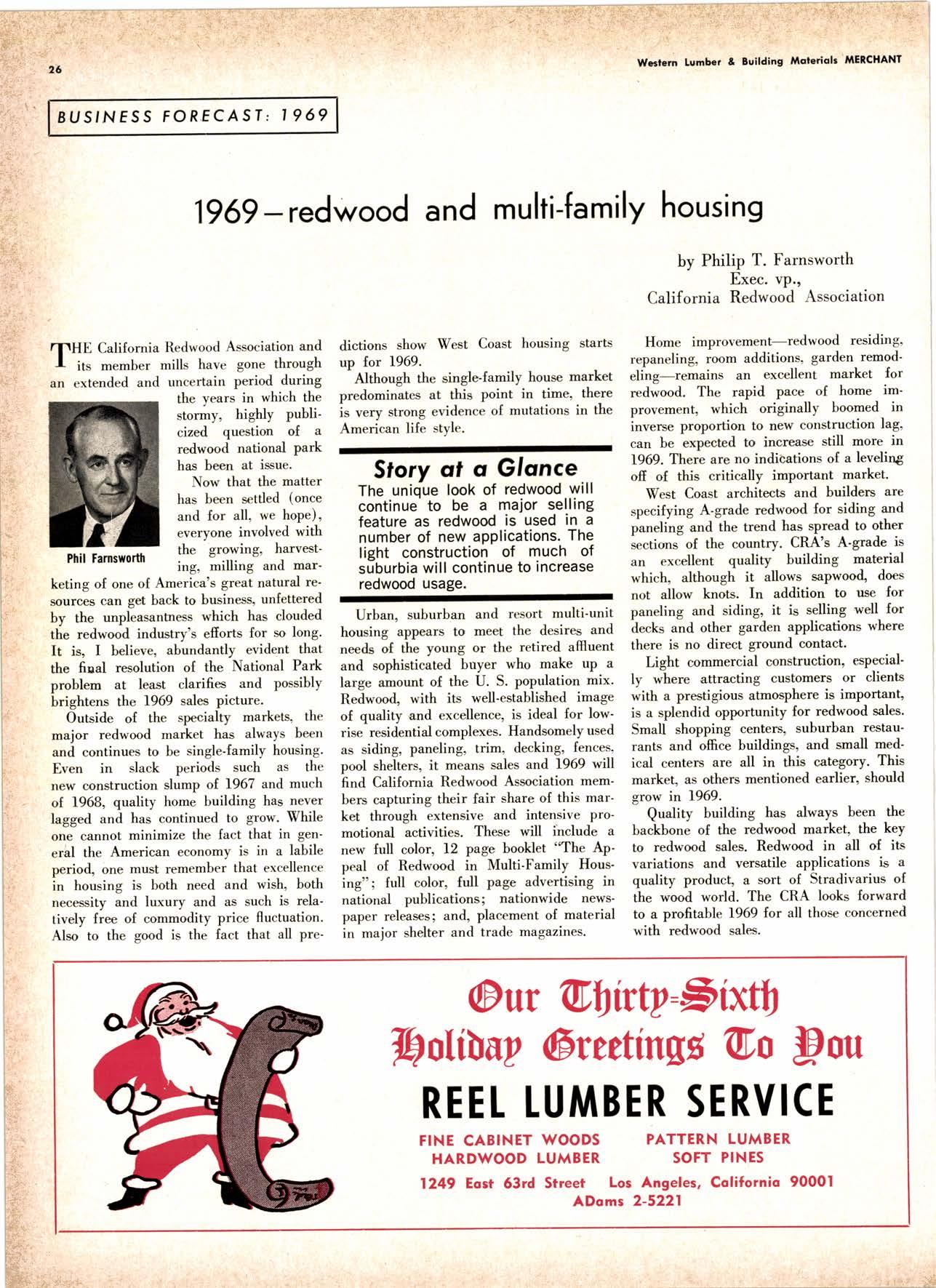
3 minute read
BUS'NESS FORECAST, 1969 1969- redwood and multi-family housing
by Philip T. Farnsworth Exec. vp., California Redwood Association
THE California Redwood Association and its member mills have gone through extended and uncertain period during the years in which the stormy, highly Publicized question oI a redwood national Park has been at issue.
Now that the matter has been setded (once and for all, we hope), everyone involved with the growing, harvesting, milling and mar' keting of one of America's great natural resources can get back to business, unfettered by the unpleasanbress which has clouded the redwood industry's efiorts for so long. It is, I believe, abundantly evident that the final resolution of the National Park problem at least clarifies and possibly brightens the 1969 sales Picture.
Outside of the specialty markets, the major redwood market has always beerr and continues to be single-family housing. Even in slack periods such as the new construction slump of 1967 and much o{ 1968, quality home building has never lagged and has continued to grow. While one cannot minimize the fact that in gen' eral the American economy is in a labile period, one must remember that excellence in housing is both need and wish, both necessity and luxury and as such is relatively free of commodity price fluctuation. Also to the good is the fact that all pre- dictions show West Coast housing starts up for 1969.
Although the single-family house market predominates at this point in time, there i, u"ty strong evidence of mutations in the American life style.
Sfory sl q Glqnce
The unique look of redwood will continue to be a major selling feature as redwood is used in a number of new aPPlications. The lieht construction of much of sJburbia will continue to increase redwood usage.
Urban, suburban and resort multi-unit housing appears to meet the desires and needs of the young or the retired affiuent and sophisticated buyer who make up a large amount of the U. S. population mix. Redwood, with its well-established image of quality and excellence, is ideal for lowrise residential complexes. Handsomely used as siding, paneling, trim, decking, fences, pool shelters, it means sales and 1969 will find California Redwood Association members capturing their fair share of this market through extensive and intensive pro' motional activities. These will include a new full color, 12 page booklet "The Appeal of Redwood in Multi'Family Hous' ing"; full color, full page advertising in national publications; nationwide newspaper releasesl and, placement of material in major shelter and trade magazines.
Home improvement-redwood residing' repaneling, room additions, garden remodelins-remains an excellent market {or redwood. The rapid pace of home improvement, which originally boomed in inverse proportion to new construction lag, can be expected to increase still more in 1969. There are no indications of a leveling ofi of this critically important market.
West Coast architects and builders are specifying A-grade redwood for siding and paneling and the trend has spread to other sections of the country. CRA's A'grade is an excellent quality building material which, although it allows sapwood, does not allow knots. In addition to use for paneling and siding, it is selling well for decks and other garden applications where there is no direct ground contact.
Light commercial construction, especial' Iy where attracting customers or clients with a prestigious atmosphere is important, is a splendid opportunity for redwood sales. Small shopping centers, suburban restau' rants and office buildings, and small medical centers are all in this category. This market, as others mentioned earlier, should erow in 1969.
Quality building has always been the backbone of the redwood market, the key to redwood sales. Redwood in all of its variations and versatile applications is a quality product, a sort of Stradivarius of the wood world. The CRA looks {orward to a profitable 1969 for all those concerned with redwood sales.
US Ply-Johns Mqnville Merger?
Talks are under way between U.S. Plywood-Champion Papers and Johns-Manville Corp. discussing the possibility'of *"tging the two giant firms.
If com'bined, the surviving corporation, U.S- Plywood, would become one of the largest building material companies in the U.S.
If they agree, the merger would be done through a tax-free exchange of stock.
Government anti-trust officials so far refuse comment, though most observers assume the government will investigate the antitrust aspects of the propoeed merger.
Cqlif. Housing Stqrts to Rise
Residential construction in California reached its 1968 peak, during September, Bank of America las reported
Housing starts rose to a seasonally adjusted annual rate of 162,000 units, tops for the year and a L3/o increase over the August rate of 143,000. They expect 20/o morc starts in 1969.
The bank emphasized that the figures represent actual starts as opposed to number of units authorized by building permits.
"This marks the lirst time since l95B that housing start statistics are available for the state," economists said. California is the only state for which actual housing start figures are now available.
Alpine'sNew Softryood Div.
Alpine Veneers, Inc. has formed a wood products div. to market a broad line of sbftwood products from western mills.
A. J. *Del" Dale,y, until recently wood products purchasing director with Weyerhaeuser Co., directs the new division, which covers the continental United States. Daley said initial emphasis will be placed on sales of rvestern and inland red cedar.
Wholesalers of West Coast
Softwoods: Douglas Fir White Fir . Ponderosa Pine
Sugar Pine . Hemlock Via Rail, T&T










